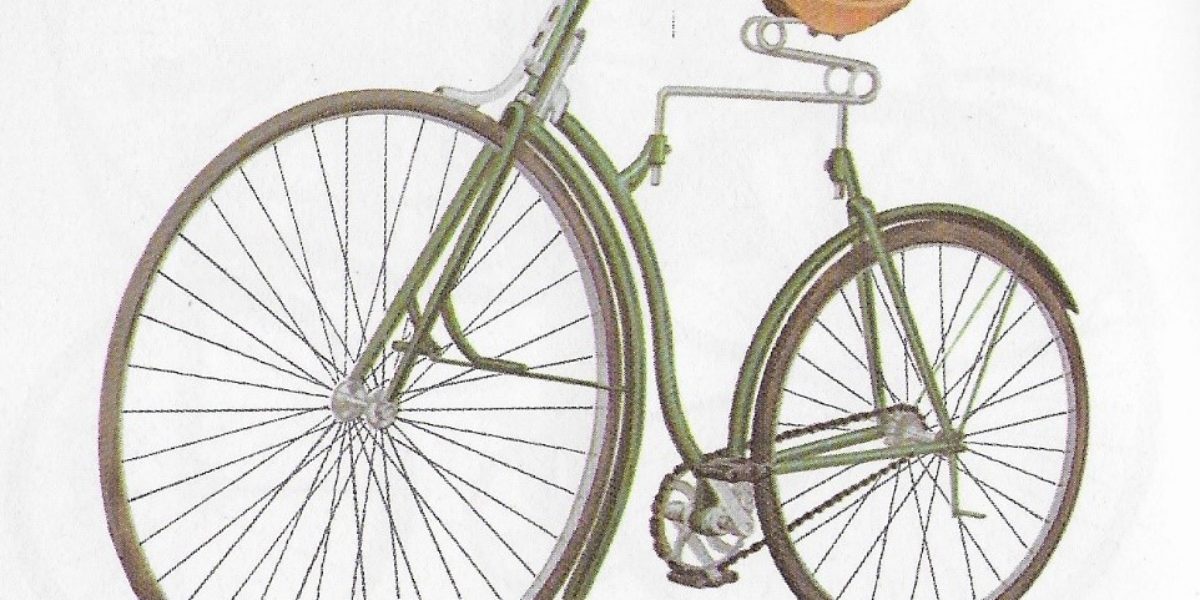Michael van Kerkhof is a journalist at Fiets & Procycling Magazine and AD Sportwereld. For the Third Floor, he wrote the article below.
To some people, a bike is just a simple form of transport. A way of getting from A to B, which you then lock up somewhere and leave for hours, days or – in the worst case – years on end. To others, cycling is a way of life. ‘A bike’s all you need’, one of the most famous Dutch cyclists, Joop Zoetemelk, once said.
Here in the Netherlands we grow up with our bicycles. Lots of us were given a balance bike as a birthday present when we were toddlers. These little bikes without pedals that you push along with your feet date back to the late 18th, early 19th century. The German inventor Karl Drais (1785–1851) came up with a means of transport in 1817 to make it easier for people to get around and that didn’t entirely depend on physical exertion. The result was a ‘swift walker’, a wooden balance bike named the Draisine.
The penny-farthing
It took until 1885, however, before a bicycle resembling the ones we know today was designed. You might have seen old photographs from before that time of a person sitting on a bicycle with a very large front wheel and a tiny back one. That’s the penny-farthing, named after old English coins of different sizes. Its pedals were fixed to the front wheel, which they rotated directly, as fast as the cyclists’ legs could manage. The first ‘high-wheeler’ of this kind was developed by the Englishman James Starley (1830–1881). It was his nephew, John Starley (1854–1901) who later came up with a bicycle with a chain drive. A cycle of this kind, with two equally sized wheels and a frame, meant that a single pedal stroke no longer had to match the speed of the rotating front wheel one to one. It was also a lot safer to take out onto the road. The cyclist had greater control over the bike and was able to react faster to unexpected events.
Counting every gram
Bicycles became increasingly popular until the rise of the car began to eat into sales. All the same, bikes never went away and to this day people continue to seek ways to make them even better, lighter and more comfortable. One of the first ‘modern’ bikes consisted of a metal frame with iron wheels and weighed pretty much the same as the person riding it. Nowadays, everything is as light as possible. And very much so in professional cycling, where minimal differences can be crucial: the less you and your bike weigh, the faster you can cycle up that mountain. So everything is done to make sure you’re carrying as little weight with you as possible. According to the UCI, the international cycling federation, a racing bike today has to weigh at least 6.8 kg. Anything less than that would be dangerous. Bicycle makers, cycling teams and cyclists themselves do everything they can to trim that weight down. One way of doing so is to use even lighter materials: iron gave way to steel, then to aluminium and ultimately to carbon. Can you have a bottle holder? You can, provided it only weighs a few grams. Because any extra weight means more physical effort.
Bicycle models
There are a whole lot more types of bicycle besides the balance bike, the high-wheeler and the racer. When the sun comes out in the Netherlands, so too do the tandems – bikes with two riders, one behind the other. Here’s an interesting fact: the tandem we know today mainly as a playful form of transport (because who really uses them to get around any more?) was once a form of competitive cycling. And not just tandems for two riders, but models for three, four or even five people. The tandem still features in sports cycling too. In the Paralympic Games, for instance, visually impaired competitors bid for sporting glory on a tandem together with a sighted companion to steer.
Then you have the e-bike, which many view as the cycle of the future. They’re often three times heavier than a racing bike, but in spite of their weight, e-bikes are a real gamechanger. The electric motor means that the rider can travel long distances with a minimum of effort. Ideal if you’re not especially fit, are getting on in age or have a physical disability. Not everyone is positive about them, though. ‘Cycling for lazy people’, is something you often hear. Which is wrong, because the e-bike actually opens a lot of doors. What, for instance, if you can’t go out with your cycling group on a Sunday morning because you can’t keep up any more? The pedal-assisted e-racing bike offers a solution and is definitely better than sitting at home feeling sorry for yourself. Or what if you can’t handle the tougher hills on the mountain biking trail like you used to? Even with a bit of support, you’ll still have to work hard to make it to the top, but there’s a much bigger chance now that you will actually do it.
Popular
So bikes might have been around for over 200 years, but the end of the popular two-wheeler is nowhere near in sight. Whether it’s a clunky bike that’s been waiting in the shed for its rider for way too long now, a Postcode Lottery bike that half the households in the Netherlands seem to have knocking around these days, or an aerodynamic racing bike with a 15,000-euro price tag. The bicycle is for everyone: for the students whooping it up around town on a party bike, for the pupils who have to get to school whatever the weather, and for the competitive cyclists who train day in, day out in the hope of one day winning a race.


